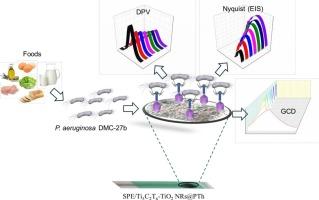多噻吩功能化Ti3C2Tx-TiO2纳米棒复合材料电化学传感平台检测铜绿假单胞菌DMC-27b
IF 4.5
2区 化学
Q1 BIOCHEMISTRY & MOLECULAR BIOLOGY
引用次数: 0
摘要
由于铜绿假单胞菌具有形成耐抗生素生物膜的能力,可引起严重的长期感染,特别是在免疫系统较弱的个体中;因此,快速检测对有效治疗至关重要。本文提出了一种基于多噻吩功能化Ti3C2Tx-TiO2纳米棒的电化学电容性生物传感器,用于铜绿假单胞菌DMC-27b的检测。利用电化学阻抗谱、循环伏安法、恒流放电和自放电等电化学方法对改性电极的电容特性进行了评价。Ti3C2Tx-TiO2 NRs的掺入显著提高了材料的电导率和电荷存储能力,比电容达到973.07 F/g。该传感器的灵敏检测范围为10-106 CFU/ml,检测限为1.0 CFU/ml。本文首次报道了Ti3C2Tx-TiO2 NRs和Ti3C2Tx-TiO2 NRs掺杂PTh纳米复合材料的合成,以及基于Ti3C2Tx-TiO2 NRs@PTh的铜绿假单胞菌电化学电容性生物传感器的研制。即使噬菌体活性逐渐下降,生物传感器也显示出良好的恢复效果,并在实际样品中检测出有希望的超级细菌。此外,所研制的Ti3C2Tx-TiO2 NRs@PTh/噬菌体生物传感器对铜绿假单胞菌DMC-27b的检测具有很高的选择性,宿主范围和现场测试结果证实了该传感器的高选择性,并进一步证明了其良好的重复性和稳定性。本文章由计算机程序翻译,如有差异,请以英文原文为准。

Polythiophene functionalized Ti3C2Tx-TiO2 nanorods composite based electrochemical sensing platform for the detection of Pseudomonas aeruginosa DMC-27b
Due to its ability to form antibiotic-resistant biofilms, Pseudomonas aeruginosa can cause serious, long-lasting infections, especially in individuals with weakened immune systems; therefore, its rapid detection is crucial for effective treatment. Herein, a polythiophene-functionalized Ti3C2Tx-TiO2 nanorods (NRs) based electrochemical capacitive biosensor is proposed for the determination of Pseudomonas aeruginosa DMC-27b. The capacitive characteristics of the modified electrode were evaluated using a combination of electrochemical methods, such as electrochemical impedance spectroscopy, cyclic voltammetry, galvanostatic discharge, and self-discharging. The incorporation of Ti3C2Tx-TiO2 NRs significantly enhanced both conductivity and charge storage, yielding a specific capacitance of 973.07 F/g. The biosensor demonstrated a sensitive detection range of 10–106 CFU/ml, with a limit of detection of 1.0 CFU/ml. This is the first report on the synthesis of Ti3C2Tx-TiO2 NRs and Ti3C2Tx-TiO2 NRs-doped PTh nanocomposites, and the development of Ti3C2Tx-TiO2 NRs@PTh based electrochemical capacitive biosensor for the detection of Pseudomonas aeruginosa. The biosensor, even with a gradual decline in phage activity, showed good recovery with promising results for detecting the superbug in real samples. Furthermore, the developed Ti3C2Tx-TiO2 NRs@PTh/Phage biosensor exhibited highly selective detection of Pseudomonas aeruginosa DMC-27b, as confirmed by host range and spot test results, and further demonstrated excellent reproducibility and stability.
求助全文
通过发布文献求助,成功后即可免费获取论文全文。
去求助
来源期刊

Bioelectrochemistry
生物-电化学
CiteScore
9.10
自引率
6.00%
发文量
238
审稿时长
38 days
期刊介绍:
An International Journal Devoted to Electrochemical Aspects of Biology and Biological Aspects of Electrochemistry
Bioelectrochemistry is an international journal devoted to electrochemical principles in biology and biological aspects of electrochemistry. It publishes experimental and theoretical papers dealing with the electrochemical aspects of:
• Electrified interfaces (electric double layers, adsorption, electron transfer, protein electrochemistry, basic principles of biosensors, biosensor interfaces and bio-nanosensor design and construction.
• Electric and magnetic field effects (field-dependent processes, field interactions with molecules, intramolecular field effects, sensory systems for electric and magnetic fields, molecular and cellular mechanisms)
• Bioenergetics and signal transduction (energy conversion, photosynthetic and visual membranes)
• Biomembranes and model membranes (thermodynamics and mechanics, membrane transport, electroporation, fusion and insertion)
• Electrochemical applications in medicine and biotechnology (drug delivery and gene transfer to cells and tissues, iontophoresis, skin electroporation, injury and repair).
• Organization and use of arrays in-vitro and in-vivo, including as part of feedback control.
• Electrochemical interrogation of biofilms as generated by microorganisms and tissue reaction associated with medical implants.
 求助内容:
求助内容: 应助结果提醒方式:
应助结果提醒方式:


